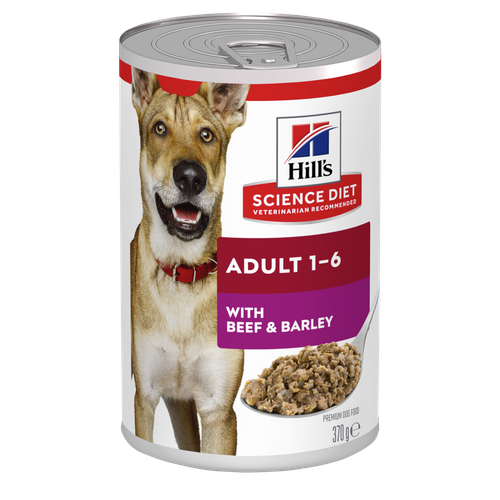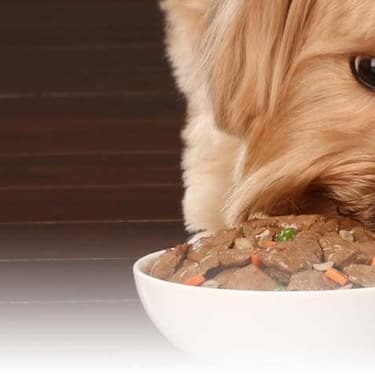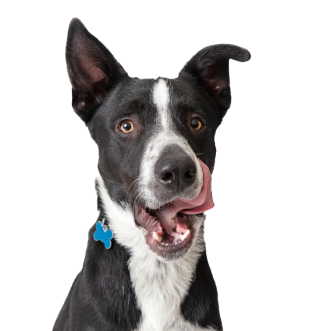
-
Find the right food for your petTake this quiz to see which food may be the best for your furry friend.Find the right food for your petTake this quiz to see which food may be the best for your furry friend.Health CategoryFeatured products
 Adult with Turkey Wet Dog Food
Adult with Turkey Wet Dog FoodTurkey & Barley recipe with precisely balanced nutrition to keep Adult dogs active and healthy
Shop Now Adult with Chicken & Barley Wet Dog Food
Adult with Chicken & Barley Wet Dog FoodChicken & Barley recipe with precisely balanced nutrition to keep Adult dogs active and healthy
Shop Now Adult with Beef & Barley Dog Food
Adult with Beef & Barley Dog FoodBeef & Barley recipe with precisely balanced nutrition to keep Adult dogs active and healthy
Shop NowFeatured products Adult 7+ Tender Tuna Dinner Cat Food
Adult 7+ Tender Tuna Dinner Cat FoodWith delicious chunks in a decadent gravy
Shop Now Sensitive Stomach & Skin Chicken & Beef Dinner
Sensitive Stomach & Skin Chicken & Beef DinnerGourmet daily nutrition, carefully made. Tasty chunks with chicken & beef in a decadent gravy. Supports digestive health, nourishes skin and promotes a lustrous fur.
Shop Now Adult Chicken & Spinach Casserole Cat Food
Adult Chicken & Spinach Casserole Cat FoodWith delicious chunks in a decadent gravy
Shop Now -
DogCat
- Cat Tips & Articles
-
Health Category
- Weight
- Skin & Food Sensitivities
- Urinary
- Digestive
- Kidney
- Dental
- Serious Illness
-
Life Stage
- Kitten Nutrition
- Adult Nutrition
Featured articles Water
WaterWater is the most important nutrient of all and essential for life. Animals can lose almost all their fat and half their protein and still survive, but if they lose 15% of their water, it will mean death.
Read More Pet Food Storage Tips
Pet Food Storage TipsWhere you store your cat and dog food can make a big difference in the quality and freshness once it is opened. Here are some common questions and recommendations for optimal storage for all of Hill’s dry and canned cat and dog food.
Read MoreHill's Australian Bushfire EffortsRead More -


Puppy development involves a lot of stages and milestones as puppies grow into adulthood. Whether you've adopted a puppy and you're wondering when he'll calm down and stop chewing on everything — or you're simply curious about what puppies go through to become full-fledged dogs — this puppy timeline has the answers you're looking for.
1. When Puppies Open Their Eyes and Ears
Puppies are born blind and deaf, with both their eyes and ears sealed shut. For their first two weeks of life, newborn pups experience the world entirely through touch and smell. During the third week their eyes and ears open, giving tiny pups a whole new way to experience life. This is typically because puppies are born without their brains fully developed unlike other mammals that have longer gestation periods.
2. When Puppies Learn to Bark
Once puppies are able to hear, they begin to mimic the sounds they hear from their mother. It doesn't take long after their ears open for puppies to go from soft grunts to full-fledged whining and barking.

3. When Puppies Learn to Walk
Puppies begin to stand around the same time their senses develop. By the third week, they begin taking their first clumsy steps, giving them a new sense of independence.
4. When Puppies Learn to Play
Once puppies become mobile, it's not long before walking leads to scampering around and playing with their littermates. At about three weeks of age, this marks the beginning of the crucial socialization stage as pups learn from their mom and siblings what it means to be a dog.
5. When Puppy Teeth Come In
The third week is a big week in the puppy timeline. In addition to the other puppy development milestones mentioned above, those sharp little puppy teeth also start to erupt. Typically, by week eight they have their entire set of deciduous teeth (puppy teeth).
6. When Puppies Learn to Go Potty
Weeks three to four is also the time when pups develop control over their bladder and bowel movements, and learn to leave their sleeping area before relieving themselves.
7. When Puppies Start Eating Solid Food
While puppies may start trying to sample mom's solid food as soon as their teeth start coming in, it's not until the fourth week that the mother's milk production starts to slow down and pups begin the permanent transition to solid puppy food. This weaning process typically takes about four more weeks, and puppies are fully weaned by week eight.
8. When Puppies Begin to Like People
The fourth week in the puppy timeline is also when puppies begin forming emotional attachments and bonds with the people around them. While it's still too early to separate a pup from his mother and littermates, this is a great time to start getting to know the puppy you intend to adopt.
9. When Puppies Need to Be Socialized
Although puppies start learning about the world and the social order within their litter by week three, weeks four through twelve make up a crucial window for socialization that will make the difference between a pup growing into a well-adjusted dog or one with emotional and behavioral problems. The earlier puppies in this stage of development can start meeting new people, interacting with other pets (but you'll want to make sure these pups are also vaccinated and have gone through their vet checks so as to not expose your puppy to anything), exploring the world, and gaining new and positive experiences, the better.
10. When Puppies Need to Be Vaccinated
According to the American Kennel Club, puppies should start receiving vaccinations between six and eight weeks. By the time a puppy is ready to be adopted, he should already be vaccinated for distemper, parvovirus, and parainfluenza. A pup will be ready for his next round of vaccinations between ten and twelve weeks of age.


Tasty Tips
11. When Puppies Can Start Being House-Trained
By week seven, says Dogtime, a puppy has developed the physical coordination and muscle control necessary to begin house-training. Accidents are still likely. His muscles continue to develop and he gains new neural pathways that help him understand how and where to properly relieve himself.
12. When Puppies Are Ready to Adopt
Once puppies are fully weaned at week eight, they're ready to leave their canine birth family and go to their new homes. This can be a delicate time. While a pup this age is still within the time frame of readily accepting new family members and new experiences, he's also shifting into a fear stage that can last until about week twelve. Puppies at this age need a lot of reassurance and positivity to keep from becoming anxious adults.
 13. When Puppies Are Ready for Obedience Training
13. When Puppies Are Ready for Obedience Training
By week nine, after he's had a chance to settle into his new home and form a bond with his new family, a pup is ready to begin basic obedience training. While some pet parents are reluctant to enroll their pups in obedience classes prior to obtaining all of their vaccinations, the American Veterinary Society of Animal Behavior points out that the socialization benefits of attending obedience classes at this age far outweigh any risks posed by not having completed vaccinations. Make sure to check with your pup's veterinarian to get their opinion first.
14. When Puppies Learn Their Place in the Household
At week twelve, a puppy's dominance and submission instincts start coming to the fore and he starts to figure out where he fits in the social order of the household. At week twelve, the fear stage gives way to curiosity as he becomes more independent and assertive. Now, he needs plenty of reassurance from his loved ones. Usually, pups are secure about their place in the family by about six months of age.
15. When Teething and Chewing Begins
Adult teeth start coming in between three and six months of age, which is when the dreaded chewing begins. It's important to puppy-proof the house at this stage, hiding or placing out of reach anything you don't want to get chewed, as well as anything that might pose a choking hazard or otherwise harm the pup, such as power cords or toxic plants. Providing chew toys during this time can help prevent him from satisfying his urge to chew on the living room rug or your favorite shoes.
16. When Puppies Are Ready to Be Spayed or Neutered
Puppies can be spayed or neutered between four and six months. This should be done no later than six months of age, in order to prevent the effects of hormones from causing disruptive behavior.
17. When Puppies Start Testing Boundaries
As adolescent pups become more independent, they may try to assert themselves in the pack order, establish dominance, and stake out their territory. It's common for pups between six and eighteen months of age to push their boundaries and challenge the authority of their human, as well as any other pets that make up their "pack."
18. When Puppies Mature and Settle Down
Puppies typically develop the emotional maturity and temperament of an adult dog between twelve and eighteen months of age, although they may continue to occasionally exhibit puppy behavior like chewing and nipping until they're about two years old. Generally, by the time a pup reaches eighteen months, he's settled into his grown-up personality and fully acclimated to his place in the family. Now this doesn't mean he won't still be a bundle of energy — this can continue for a few years depending on the dog, which is why regular exercise and training is important for him to learn proper behaviors.
Normal puppy development certainly comes with challenges, and more often than not those challenges will try the patience of new puppy parents. But the puppy timeline, watching a pup grow from infancy to adulthood, also comes with a multitude of rewards.


Jean Marie Bauhaus is a pet parent, pet blogger, and novelist from Tulsa, Oklahoma, where she usually writes under the supervision of a lapful of fur babies.
Related products

Clinically proven kibble technology to reduce plaque & tartar build-up, specially designed for small & mini dogs

Supports lean muscle for dogs who prefer smaller kibble

Supports energy level and beautiful coat in mature dogs who prefer smaller kibble

Supports healthy joints, lean muscle, and beautiful coat for large breed dogs
Related articles

Selecting the right food for your puppy is a key to quality nutrition and a long, healthy life., Learn more about how to select the right puppy food.

Learn how today's wet dog food blends have gotten a face lift, and how you'll provide your dog the nutrition he needs in the form he loves.

Extra pounds can cause problems for your dog's overall health. Learn the signs that your dog might be overweight, and what you can do to manage its weight.

As small and toy breed dogs age, their nutritional needs change.

Put your dog on a diet without them knowing
Our low calorie formula helps you control your dog's weight. It's packed with high-quality protein for building lean muscles, and made with purposeful ingredients for a flavorful, nutritious meal. Clinically proven antioxidants, Vitamin C+E, help promote a healthy immune system.
Put your dog on a diet without them knowing
Our low calorie formula helps you control your dog's weight. It's packed with high-quality protein for building lean muscles, and made with purposeful ingredients for a flavorful, nutritious meal. Clinically proven antioxidants, Vitamin C+E, help promote a healthy immune system.

